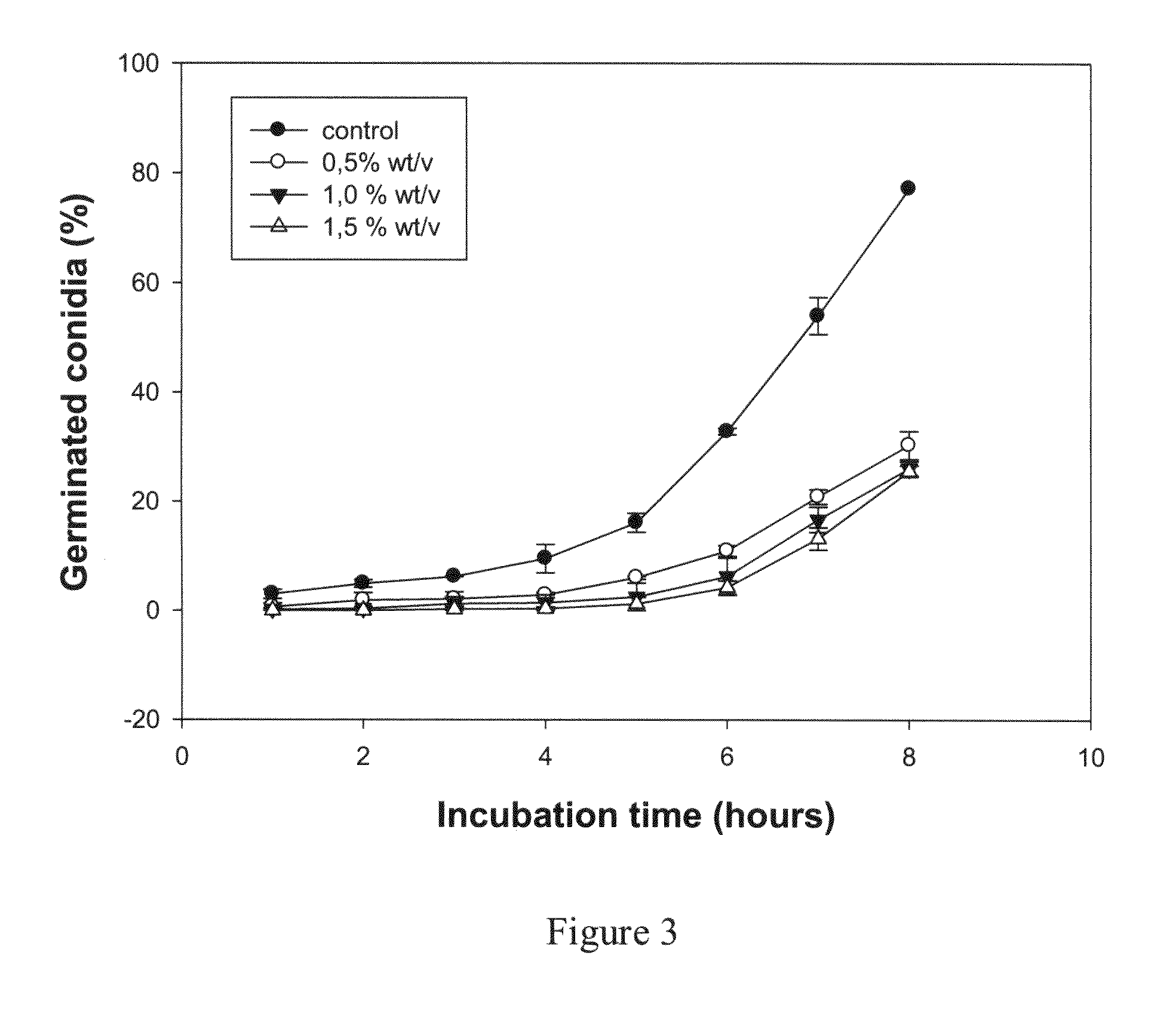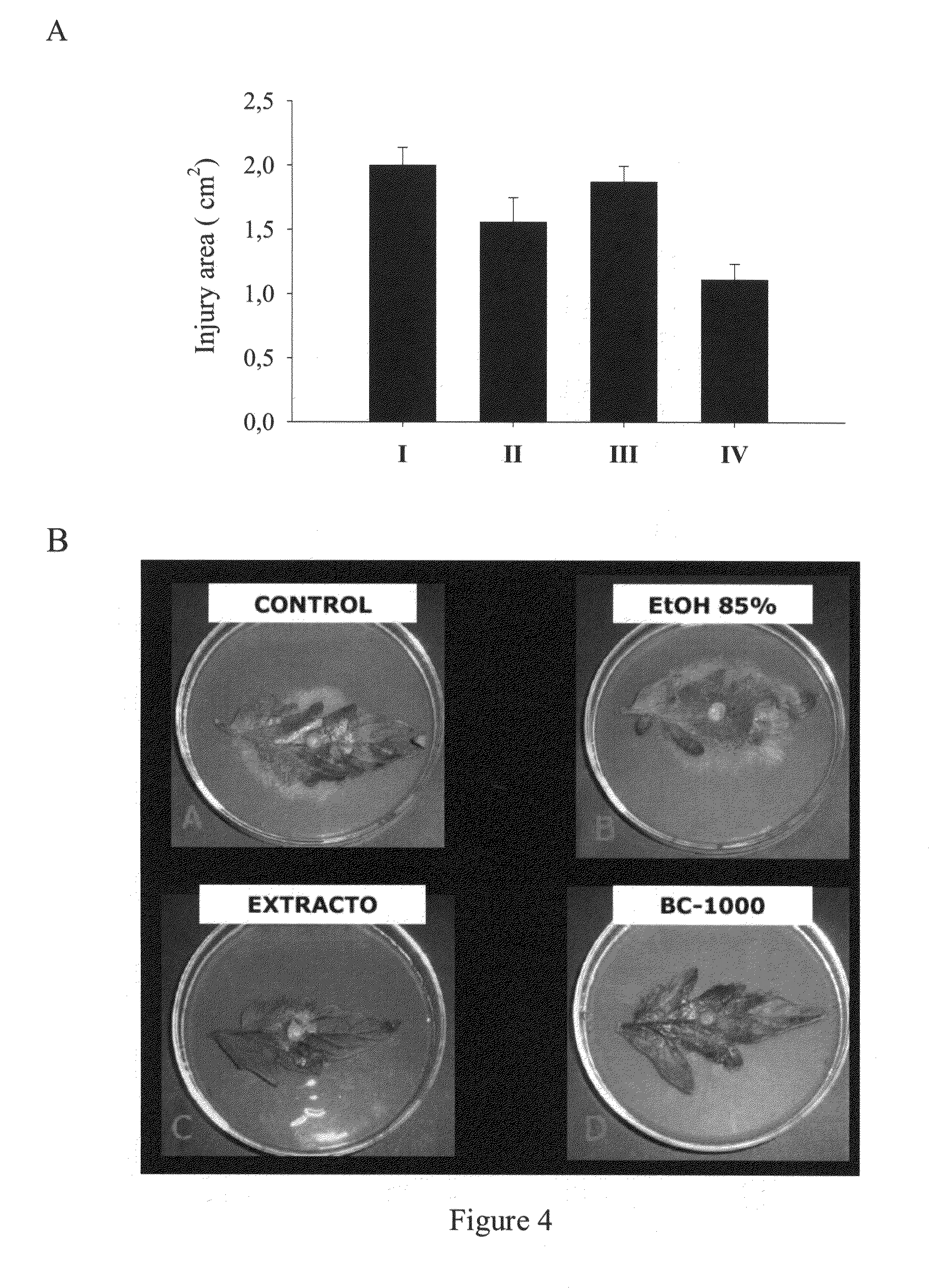Natural extract for the control of botrytis cinerea at pre- and post-harvest
a technology of natural extract and botrytis cinerea, which is applied in the field of natural extract for the control of botrytis cinerea at pre and postharvest, and can solve the problems of large losses for farmers, overexploitation of products, and strong influence on the chemical composition of plants
- Summary
- Abstract
- Description
- Claims
- Application Information
AI Technical Summary
Benefits of technology
Problems solved by technology
Method used
Image
Examples
example 1
Quillay Multiplication System
[0046]Multiplication of seedlings: A system of in vitro cultivation of quillay was implemented from axillary leave shoots. Optimization of disinfection methods for explants and the formulation of the cultivation medium allowed the proper development of the shoot micropropagation stage.
[0047]Explants were transplanted for 15 days in a MS substrate, to which the following was added: myoinositol (100 mg / L), glycine, thiamine (1 mg / L), PVP (to reduce the formation of compounds deriving from the oxidation of phenols), sacarose (20 g / L) and agar (7.5 g / L); then the pH was adjusted to a value of 5.5 by using KOH or HCl 0.1 to 1 N prior to autoclaving at 120° C. for 20 minutes. The agar was mixed with the cultivation medium in order to obtain its solidification, and then the suspension was stirred and heated to a temperature of about 90° C. About 20 ml of substratum were transferred to the inside of 200 mL cultivation bottles, covered with aluminum foil, and the...
example 2
Obtainment of Extracts and Evaluation of the Activity
[0053]For the obtainment of vegetal extracts, fresh quillay shoots were used after 1 month of in vitro sub-cultivation, as described in the example 1; for the extracts from plants under natural conditions of growth (in vivo conditions), new leaves were used (fresh tissue) of adult specimens, obtained from the Mahuida Parque located at the “Precordillera” area, Metropolitan Region, Chile. The extracts of in vitro shoots were prepared by immersing 5, 10 and 15 g of tissue in 100 ml of solvent (5, 10 or 15% p / v), while the extracts of in vivo plants were prepared only at a 10% p / v concentration.
[0054]The extracts were prepared through maceration and diffusion techniques. Under the former, the tissue was crushed in liquid nitrogen using ceramic mortar and pestle prior to the waterish or hydroalcoholic extraction (ethanol 85% v / v) cold, for 15 min in dark conditions. For the diffusion extraction, the vegetal material cut in small piece...
example 3
Effect of Quillay Extracts on the Germination of Conidia
[0057]The trial was conducted in microscope slides, to which effect 5 ml of the cultivation medium agar extract soft yeast-malt were placed, supplemented with the ethanolic extract of quillay in vitro shoots at final concentrations of 0.5, 1.0 and 1.5% p / v or the solvent as control. After the evaporation of the solvent and gellification of the cultivation medium, the slides were inoculated with dry conidia by delicately spreading on the cultivation medium a piece of agar taken from the esporulated cultivation after 10 days of incubation (22° C. in dark conditions). After the inoculation, the slides were placed inside humid chambers and incubated at 22° C. for 11 hours. The germination of conidia was directly determined in the slides at the intervals of hours observing the samples with an Optical Microscope. Only those conidia with a germinative tube equal to or above the conidial diameter were considered germinated (Inyang et a...
PUM
 Login to View More
Login to View More Abstract
Description
Claims
Application Information
 Login to View More
Login to View More - R&D
- Intellectual Property
- Life Sciences
- Materials
- Tech Scout
- Unparalleled Data Quality
- Higher Quality Content
- 60% Fewer Hallucinations
Browse by: Latest US Patents, China's latest patents, Technical Efficacy Thesaurus, Application Domain, Technology Topic, Popular Technical Reports.
© 2025 PatSnap. All rights reserved.Legal|Privacy policy|Modern Slavery Act Transparency Statement|Sitemap|About US| Contact US: help@patsnap.com



